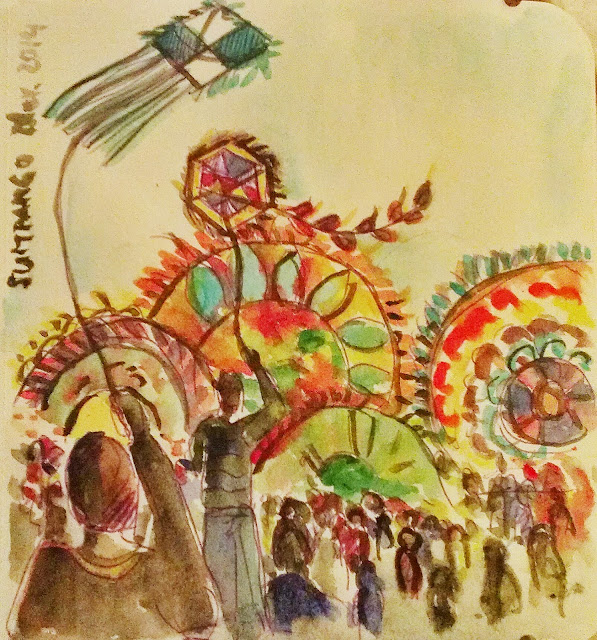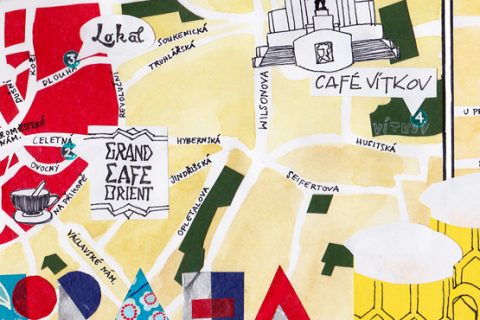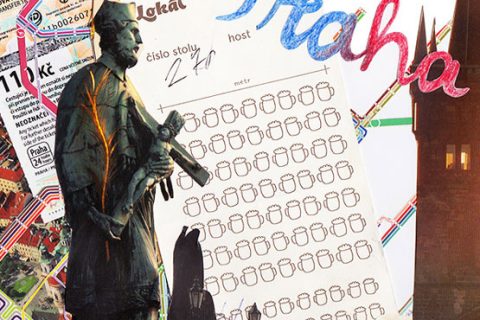Being in a religious country means to suddenly find oneself in the midst of holy festivals and Christian celebrations. And Guatemala certainly is among those countries. One example is All Saints‘ Day, celebrated in western Christianity on the 1st of November. In Guatemala it is a tradition to visit the cemetery and to give offerings to the death. This can be in form of flowers and/or food – you cannot imagine how packed the market was one day before All Saints‘ Day. Furthermore, a common dish which is served this day is called ‚fiambre‘, a combination of cold cuts and vegetables.
Some villages have special traditions in addition to the normal celebration. The villages Sumpango and Santiago de Sacatepéquez are famous for celebrating the ‚Día de Todos los Santos‘ with giant, colorful kites. In both villages this in an ancient tradition, recognized as cultural heritage in Guatemala. Normally groups of five to ten young men work together on one kite. They start several month before the 1st of November. Creating such a kite can mean 6 hours of daily work during the night and early morning in order to finish it on time. Usually the kites have a diameter between 1 and 10 meters. However, they can even reach a diameter of 16 meters. The kites are made of colored translucent paper attached to a bamboo structure. All of them have also fringes on the sides and a tail in order to give balance to the kites when in the air.
In Sumpango Sacatepéquez the festival is based upon an ancient legend. This legend says that with every arrival of the All Saints‘ Day bad spirits would haunt the cemetery and disturb the good souls. For this reason, these human souls would stroll disquietingly around the streets and houses in Sumpango. The villagers consulted a spirit which advised them to stimulate the withdrawal of the bad souls by placing paper pieces against the wind. The impact of the wind on the paper would eliminate the disturbance it was said. This is how the villagers started to elaborate objects which resembled huge kites. In the end, the creation of the kites made that the good souls kept quiet again.
Nowadays, this tradition has grown to a huge event in Sumpango for locals and tourists alike. Each year they celebrate a kite competition in different categories, depending on the size or the decoration. Each group of kite constructors has only one wish: to get the kite high into the air and to keep it there for a long time. Hundreds of spectators come every year to admire the colorful kites, to eat and to celebrate this ancient tradition.
 |
| Colorful kites in Sumpango |
In Santiago Sacatepéquez the kite festival is religious as well as cultural tradition, because the villagers believe that the kites are a communication link between the souls of the loved ones and themselves. The kites act like peace messengers, as the villagers attach messages to them. The festival is held on the cemetery itself. People come there to see the kites, to eat and drink, to make offerings to their loved ones and to celebrate with the dead souls as well as with each other.
Of course, to immerse oneself in these traditions is something unique. The huge, colorful kites are stunning and beautiful. It is a totally different feeling to see the cemetery crowded of people. Everybody eats, drinks, chats, stands or sits on the graves, lets kites fly and has fun. Of course, after that the cemetery looks like a huge open-air festival took place over there. Trash lies around everywhere, the majority of the flowers on the graves are trod down and the ground looks like a horde of wild horses has just passed by. But it seems that this is just part of the party over here.




 Ich schreibe und ich reise. Mal bin ich ganz weit weg, mal erkunde ich meine Stadt oder nur meinen Block, manchmal reise ich durch mein Zimmer. Dazu gibt es meistens Zeichnungen aus meinem Sketchbook. Auch mal Fotos. Und vielleicht bringe ich von der ein oder anderen Reise auch ein leckeres Rezept mit. Hier findest du all meine Erinnerungen. Schön, dass du vorbei schaust!
Ich schreibe und ich reise. Mal bin ich ganz weit weg, mal erkunde ich meine Stadt oder nur meinen Block, manchmal reise ich durch mein Zimmer. Dazu gibt es meistens Zeichnungen aus meinem Sketchbook. Auch mal Fotos. Und vielleicht bringe ich von der ein oder anderen Reise auch ein leckeres Rezept mit. Hier findest du all meine Erinnerungen. Schön, dass du vorbei schaust!